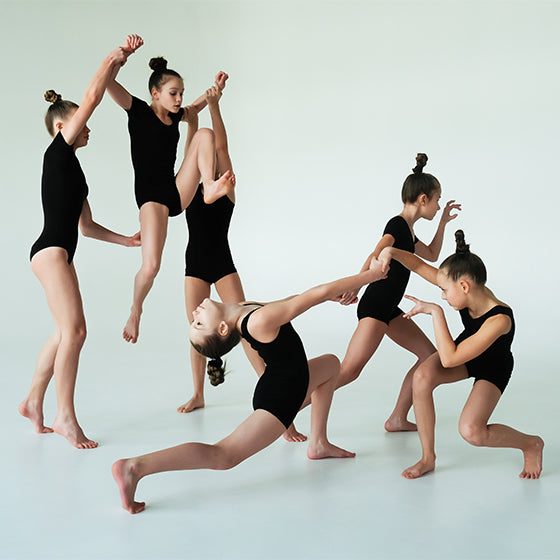Do you want to dance with more confidence? You should!
No matter how clean your pictures or how ~textured~ your moves are, you will not “slay,” “kill,” or “murder” anything unless you dance with more confidence.
The most captivating dancers are those who look comfortable in their own bodies and really commit to their performance.
So, how do you develop that confidence, then use it in your dancing? Check out these tips to help you dance with more confidence!
1. Name What You Love About You
Find the things that you love as your best qualities, and even call them out verbally while you look at your reflection, Diamond says. It's all about seeing what you do have, rather than focusing only on what you don't, says Tina LeBlanc, ballet master at San Francisco Ballet and a veteran teacher who has been vocal about her own struggles to accept her body as a performer. "I knew I couldn't change my proportions—I never had much of a waist or long legs—but I had speed and technique."
2. Learning New Choreography Makes You Feel Good
Once you start attending dance classes, there will be a lot of new steps to learn. Now, it won’t be easy in the beginning, especially if you’ve never danced before and you’re just starting out. However, as time goes on, you’ll notice how your dancing skills improve as you learn more and more new steps.
After a while, you’ll know a bunch of steps, and as we all know, learning and remembering the whole choreography is no easy task. So, once you get a hold of the new things you learn, you’ll feel much more capable, and this new sense of achievement will only increase your motivation for learning new steps so you can dance even better.
3. Focus On How You Feel
Trying to conform to a certain look for an audition can backfire if it makes you feel insecure. "You see people book jobs by wearing the crop top and briefs, so you think you have to, but that's not what makes me comfortable enough to dance my best," says Traci Swartz, a performer in Los Angeles who also works at a talent agency. "Now, I wear what makes me feel amazing."
Being confident is also enjoying the feeling of your body within the movement. "Let go and the audience will enjoy it too," says LeBlanc. "I wish I would have danced my whole career like I did in my final performance, when I was no longer trying to be perfect."
4. Be Grateful for What Your Body Can Do
When you're zeroed in on one flaw, it's easy to forget all the amazing things our bodies are capable of. Remind yourself what a feat it is to extend your leg past your ear or pull off a clean triple pirouette. Some dancers only learn this lesson after an injury or a leave of absence.
"I've seen many dancers come back after having children with more perspective and balance about their body image," says Diamond.
5. Focus on Your Goal, One Step at a Time
Stopping the vicious cycle of self-doubt begins with the realization that your identity (and worth) is not pinned to how you dance in class or onstage. Learning to not take feedback personally is key, says Goonan. “Corrections are not an attack on who you are,” he says. “If you can think of them as being about what you’re doing, rather than about you, it creates better health.”
Ringer notes that the student/teacher relationship is not a passive one, and that you should both ultimately want the same thing: to make you a better dancer. “You don’t just come to class to receive corrections and be told what’s good or bad,” she says. “You go into it as a partnership, with your own goals as well as the teacher’s. It’s important to feel like you’re on the same path.”
Reining in perfectionism can help, too. Virginia Johnson, artistic director of Dance Theatre of Harlem, says that the trick is to balance reality against the ideal. “The ideal is something you use as your compass, but it’s not actually possible to attain,” Johnson says. She advises dancers to measure their goals with what they are equipped with to get there. “Polish your strengths so they’re the center of attention, and know what can and can’t be done to change your weaknesses.”
Summoning up the courage to risk failure is another step in building self-confidence, and it takes practice. But knowing that you’ve pushed yourself out of your comfort zone will give you a well-deserved boost, along with the resiliency to try again. “It’s about giving yourself value,” says Ringer. “You’re worth it to try, and even if it’s not perfection, you’ve accomplished something.”
Bromberg’s turning point came when she realized that acknowledging her weaknesses didn’t mean giving in to them. Setting her own goals, instead of worrying about how she measured up to others, helped her reignite her ambition and overcome her reliance on positive messages to feel good. Progress, she realized, comes in increments, so she set more realistic goals that she could build upon over time. “Trying your best doesn’t mean nailing every turn or jump, but doing and giving everything you can on any given day.”
In the topsy-turvy dance world, even the most self-assured principals are dealt disappointing blows. Ultimately, the key to regaining your confidence after the inevitable setbacks is remembering what’s driving you to dance in the first place. Without your own passion as your anchor, you become too dependent on other people’s approval to feel good. “The ballet world is so fickle,” says Ringer. “There are huge highs and huge lows, on an hourly basis. It’s important to have a solid sense of self that can ride out the ups and downs.”





















